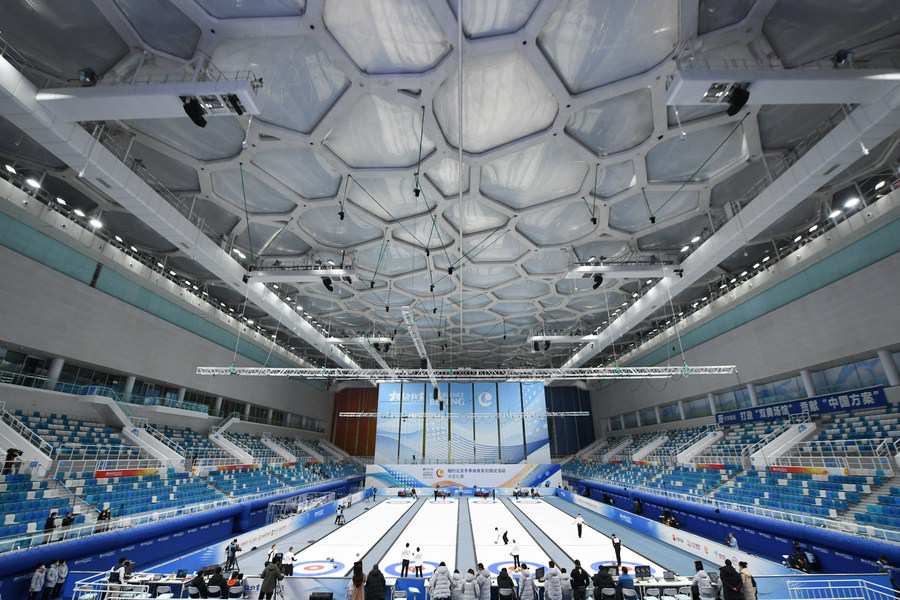Countdown to Beijing 2022 | BOCOG makes breakthroughs in carbon neutrality

A curling test competition is held at the National Aquatics Center in Beijing, on April 1, 2021. (Xinhua/Ju Huanzong)
Beijing 2022 has made progress in achieve carbon neutrality with environmentally-friendly power supply, venue construction and transportation.
BEIJING, May 27 (Xinhua)-- Green power supply, green venue construction and low-carbon transportation are among the measures that Beijing 2022 is taking in order to honor its promise of hosting a green games.
This was highlighted by the Games organizers' (BOCOG) in a press conference here on Wednesday.
In 2019, the BOCOG issued a Carbon Management Plan, proposing 18 carbon emission reduction measures that guides its endeavor to achieve carbon neutrality.
"Venue construction and energy supply are the important foundation and guarantee for the successful hosting of the Olympic Games," Liu Yumin, director of Planning and Construction Department of BOCOG said, adding that all venues of Beijing 2022 have already been covered by an urban green power grid.
"So far, 19 games venues have used green power in advance during the construction, and all venues of Beijing 2022 will utilize a clean energy supply during the Games," Liu said. "By the end of the 2022 Paralympic Winter Games, the venues are expected to consume about 400 million kilowatt hours of green power, which will reduce standard coal combustion by 128 thousand tons, and reduce carbon dioxide emissions by 320 thousand tons."
Beijing's commitment in reducing carbon footprint is also seen in the 2022 Games' full use of venues from the 2008 Summer Games, which effectively saved space and reduced the waste caused by demolition.

The construction site of a converter station for the 500-kilovolt flexible DC power grid is seen in Kangbao County of Zhangjiakou, north China's Hebei Province, May 8, 2019. (Xinhua/Yang Shiyao)
All the new venues use optimized construction materials and meet the three-star standard of green building. At the same time, the evaluation standard of green snow sports venues was developed. This is the first evaluation standard for green snow sports venues both domestically and internationally.
For the first time in Olympic history, carbon dioxide was used as a refrigerant in ice-making in four venues, which greatly reduces damage to the ozone layer as well as energy consumption. Compared with the traditional refrigeration method, it can save more than 30% in efficiency.
Most of the venues have set up energy management and control centers, which use big data and artificial intelligence analysis to collect, record and analyze the energy consumption data of water, electricity, gas and heat in real time, so as to realize visual and intelligent building energy consumption and carbon emission monitoring and management.
In addition, water-saving measures have been taken in all venues, such as using water-saving appliances.

Workers prepare for a speed skating test competition at the Capital Gymnasium in Beijing, April 3, 2021. (Xinhua/Peng Ziyang)
Beijing 2022 also aims to break ground in green transportation, trying to become the Olympic Winter Games that deploys the highest proportion of environmentally-friendly vehicles.
According to the current vehicle planning, energy saving and clean energy vehicles account for 100% of the passenger cars and 85.84% of all vehicles used in Beijing 2022.
Zhao Tongan, Deputy Director of Transportation said that during the Beijing Winter Olympics, transportation services will use clean energy supply and promote the use of hydrogen fuel vehicles.
"In order to provide safe, efficient, reliable and environmentally-friendly transportation services, we have taken into account the environment the vehicles will be used, such as high mountains and slippery roads, low temperatures and steep slopes, and ultra long driving distances," said Zhao. "On the premise of safety, we have made maximum use of energy-saving and clean energy vehicles to reduce carbon emissions."
During the event, the application of the new energy vehicles is expected to reduce about 11,000 tons of carbon dioxide, equivalent to the carbon sequestration of more than 30 square kilometers of forest in a year.
Meanwhile, in order to guarantee the use of hydrogen fuel vehicles and pure electric vehicles, Beijing and co-host Zhangjiakou are building a hydrogen station, charging pile and other supporting facilities as planned to meet the energy supply demand of hydrogen fuel and pure electric vehicles.
Photos
Related Stories
- China slams U.S. call for diplomatic boycott of Beijing Winter Olympics
- China urges U.S. politicians to stop playing 'political tricks'
- China speeds up top-level design for carbon-neutral push
- EU vows to develop sustainable maritime economy for carbon neutrality
- China pools nationwide efforts to foster low-carbon lifestyle for national goal of peaking carbon emissions and achieving carbon neutrality
Copyright © 2021 People's Daily Online. All Rights Reserved.










